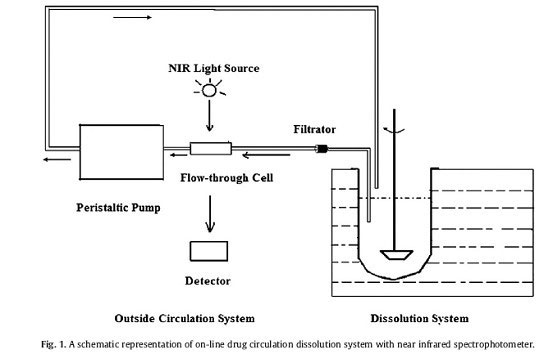1. On-line Dissolution Determination of Baicalin in Solid Dispersion Based on Near Infrared Spectroscopy and Circulation Dissolution System
Hongyuan Mou, Xuejiao Wang, Tian Lv, Lian Xie, Hongping Xie
Chemometrics and Intelligent Laboratory Systems 105 (2011) 38–42
ABSTRACT: Drug on-line circulation dissolution system with near infrared spectrophotometer for dissolution determination was reported in this paper and subsequently partial least squares (PLS) calibration model was established for concentration prediction of Baicalin in solid dispersion. When the main factor number in PLS calibration model was 6, the correlation coefficients of PLS calibration samples and prediction ones were all 0.9999 and the relative standard deviations were 0.69% and 1.10%, respectively, which showed good robustness and predictability. Combining drug circulation dissolution system with the PLS calibration model, dissolution of Baicalin in raw material drug and solid dispersion were obtained at different times. The results indicated that the dissolution property of Baicalin in solid dispersion (especially at the early time) had been significantly improved. The accumulated dissolution of Baicalin in the solid dispersion at 45 min reached nearly 40%, increasing by 15% compared with raw material drug (about 25%). The aforementioned PLS model associated with drug circulation dissolution system provided a simple, accurate and on-line support for dissolution determination of drug, especially at the early time of rapid dissolution.

2. Studies on Short Tandem Repeats Genotyping and its Expert System Based on Ultraviolet Spectroscopy- Principal Discriminant Variate
Zaizhen Wu, Hui Lu, Bin Zhang, Lian Xie, Yuzhen Gao, Hongping Xie, Bingren Gu
Chemometrics and Intelligent Laboratory Systems 105 (2011) 181–187
ABSTRACT: The paper has presented a method which could be used to detect short tandem repeat (STR) rapidly, simply and low-costly based on ultraviolet spectroscopy combined with principal discriminant variate (PDV) of chemical pattern recognition. Genotypes 10-11, 11-11 and 10-12 of STR locus D16S539 which was commonly used in forensic medicine were used to establish two-classified PDV genotyping models. The conditions of polymerase chain reaction (PCR) and ultraviolet spectral detection were optimized. Based on the optimal PCR conditions, each genotype was amplified twice in parallel. For the PDV model of 10-11 and 11-11, the prediction samples were all distributed in the scope of calibration samples, the between-class distances were big enough and the prediction accuracy was up to 100%, which indicated that the established PDV model could be used to discriminate genotypes with only one core repeat unit difference. Then the PDV model for genotypes 11-11 and 10-12 whose difference was even smaller (the total numbers of the two genotypes were both 22) was established. The model displayed the same classified characteristics as the above-mentioned one. Therefore, we assumed that the ultraviolet spectrum (UVS)-PDV method could be used to discriminate the genotypes with various degrees of differences. Subsequently, the expert system for six genotypes of the D16S539 locus was constructed based on their difference in the total number of core repeat unit. The 5 two-classified PDV models in the expert system all displayed satisfactory robustness and the discrimination ratios of the prediction samples were all 100%. The result indicated that the expert system based on the UVS-PDV method could be used to discriminate multi-genotypes of STR locus. Based on UVS, the paper achieved the detection of STR genotypes rapidly, simply and low-costly.
